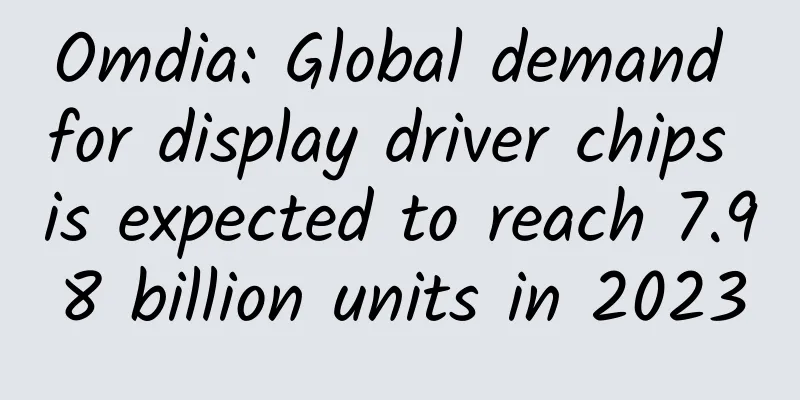Omdia: Global demand for display driver chips is expected to reach 7.98 billion units in 2023

|
According to Omdia's latest "Display Driver Chip Market Tracking Report-1Q23" database , the total demand for DDICs in 2023 is expected to be 7.98 billion, the same as in 2022. The demand for LCD display driver chips in 2023 will reach 6.94 billion, a year-on-year decrease of 0.2%, which is better than expected; while the demand for AMOLED display driver chips is expected to be 1.04 billion, a year-on-year increase of 3%, which is lower than expected. In terms of LCD display driver chips, shipments of LCD smartphone display driver chips exceeded expectations in the first quarter of 2023 and continued to increase in the second quarter as OEMs, distributors and agents began to replenish the inventory of a-Si TFT LCD smartphone panels for future demand. Therefore, Omdia expects the demand for LCD smartphone display driver chips to increase by 0.4% year-on-year in 2023. In addition to smartphones, demand for TFT LCD display driver chips in areas such as LCD TVs, industrial control, smart watches and automotive will also grow in 2023. On the other hand, due to continued weak demand in the terminal market, demand for display driver chips in IT applications such as desktop monitors, laptops and tablets is expected to continue to decline in 2023. Therefore, Omdia expects the total demand for LCD display driver chips to fall by 0.2% year-on-year in 2023, slightly higher than the previous forecast of a year-on-year decline of 1%. In terms of AMOLED display driver chips, due to weak demand for rigid AMOLED smartphones, the demand for AMOLED smartphone display driver chips in 2023 will be lower than previously forecast. The annual growth rate of AMOLED smartphone display driver chips is expected to be only 4% in 2023, down 6 percentage points from the previous forecast. Coupled with the decline in demand for AMOLED smartwatches, Omdia expects that the total demand for AMOLED DDICs in 2023 will only increase by 3% year-on-year. Omdia predicts that global DDIC demand will recover in 2024 and grow 6% year-on-year Omdia expects display panel unit shipments to grow 4% year-on-year in 2024. Panel unit shipments for most major applications, including mobile phones, mobile PCs, LCD TVs, OLED TVs, and desktop monitors, are expected to resume growth due to the arrival of a new replacement cycle and price elasticity. As a result, DDIC demand is expected to grow 6% year-on-year in 2024 to 8.48 billion units. In 2024, demand for LCD display driver chips for desktop monitors and notebook computers is expected to resume growth. Combined with the continued growth of LCD TV and LCD smartphone display driver chips, demand for LCD display driver chips is expected to increase by 5% year-on-year in 2024. Omdia expects that demand for AMOLED smartwatch display driver chips will resume growth in 2024, while demand for AMOLED display driver chips in IT applications will also grow next year. Coupled with the continued increase in demand for AMOLED smartphone display driver chips, it is expected that demand for AMOLED display driver chips will resume double-digit growth in 2024, reaching 17%. Omdia expects demand for DDIC to continue to grow slowly over the long term as higher resolutions become more and more permeable in many large-size applications. |
<<: Ten questions and answers about COVID-19 "re-positivity" and "reinfection"!
Recommend
Is it good to take a bath if you have vaginitis?
When women reach a certain age, they will have so...
What are the symptoms of fetal hypoxia at 8 months of pregnancy? What should I do if the fetus is hypoxic at 8 months of pregnancy?
We all know that after a woman becomes pregnant, ...
Omdia: Global smartphone shipments totaled 269 million units in the first quarter of 2023, a year-on-year decrease of 12.7%
According to Omdia's latest smartphone shipme...
What causes huge menstrual blood clots?
Women's bodies undergo significant changes du...
Will there be fluid accumulation in the pelvic cavity during ectopic pregnancy?
After B-ultrasound examination, if fluid is found...
What are the benefits and functions of dried mussels? How to eat dried mussels
Dried mussels are very important for maintaining ...
Can I have sex with uterine fibroids?
Uterine fibroids are a common disease among moder...
What is the prospect of chicken farming in 2020? Is the profit of chicken farming high in 2020? Market forecast
This year, the poultry industry, whether it is la...
Subtle insights from the window of childhood: revealing the secrets of atrial septal defect
Author: Zhang Xin, Chief Physician, Beijing Child...
What are the types of scented teas? Which scented tea tastes better?
Scented tea is a common type of tea in life. It i...
Experts reveal that dark menstrual blood does not mean irregular menstruation
There are many reasons for irregular menstruation...
Why do women's buttocks bleed?
Some female friends may often encounter this situ...
Can I get pregnant if the fallopian tube fimbria is adhered?
Some people nowadays pursue DINK family life and ...
Why is the vaginal discharge brown in the Qing Dynasty?
Leucorrhea is a secretion from the female body. M...
What should I do if I have vaginal bleeding during masturbation?
Vaginal bleeding due to masturbation may very lik...









